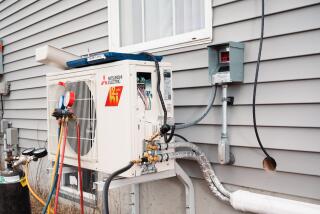DO-IT-YOURSELF : Homeowners Go Off the Grid Harnessing Sun, Wind and Water
- Share via
Ivan Forbes first thought about energy self-sufficiency while having to wait in line for gasoline during the Arab oil embargo of 1973.
“I thought there should be something that ordinary people could do to help themselves,” he said. “I didn’t like being dependent on somebody.”
He and his wife, Elke, determined that there were several forms of alternative energy they could adapt to the three-level Sylmar home they had built in 1964.
First, they installed a solar panel system. “We researched it,” said Forbes, an environmental regulations inspector. “Most people just put in enough to heat their water, but we put in 14 panels that heat our water, our Jacuzzi and our house.”
Later, they added an underground geothermal cooling system, a solar dome for their Jacuzzi and photovoltaic cells on the roof to power their refrigerator (although they do have backup transformer for use on cloudy days.)
Then, they installed a wind turbine that powers a generator.
“We’re kind of like pioneers--we have done things that other people just talk about,” he said. “I’m not totally off the grid, but I still have a great feeling of accomplishment.”
Indeed, only a few years ago, living “off the grid” meant you were located on a mountaintop or remote farm, far from a utility company. It meant kerosene lamps, iceboxes and wood-burning stoves.
Today, a small but growing number of homeowners, rural and urban, are discovering new ways to generate their own power from renewable sources such as sun, wind and water. They are discovering ways to live with CD players, computers, dishwashers and VCRs--and no utility bill. Encouraged by no stranger bedfellows than the very utility companies they seek to escape, they are achieving energy independence.
And today, they will celebrate with a national open house.
The first National Tour of Independent Homes is the project of environmentalist John Schaeffer, whose Real Goods Trading Co. has been selling mail-order alternative energy products, such as solar panels and low-energy light bulbs, since 1978.
“We felt like the country needed a boost,” Schaeffer said. “We’d like for mainstream America to see that solar is a viable alternative, even in the city.”
More than 160 homes in varying stages of energy independence will be open for public inspection across the country, including the Forbes home and four others in Southern California.
It’s Schaeffer’s hope that a close-up look at the way the sun’s power can be used to heat water in pipes, or converted to electricity through photovoltaic cells, will give visitors a new appreciation of the strides made in the technology.
“Everybody accepts a solar wristwatch or hand calculator these days, but they don’t carry that over to a house,” he says. “No one thinks of solar running their computers or microwaves.”
Michael Potts calls it the dawning of a new age. Potts, a writer and teacher who lives in Caspar, north of San Francisco, recently traveled the country from Vermont to Hawaii, interviewing people living off the grid.
In his new book, “The Independent Home: Living Well With Power From the Sun, Wind, and Water” (Chelsea Green), Potts estimates that the number of independently powered homes in the United States--those totally off the grid--has grown from fewer than 1,000 in the mid-’70s to more than 100,000 today.
Most utilities have aggressive energy conservation programs to forestall the high cost of building new power plants.
“We consider energy conservation the power plant of the future,” said Lucia Alvelais, a spokeswoman for the Los Angeles Department of Water and Power. “We have a hot line set up to give customers tips on saving water and energy, and we have a whole array of programs, such as free installation of compact fluorescent lamps, for consumers. When people start looking at alternative energy, we don’t see it as a threat at all.”
Southern California Edison is researching fuel cells, photovoltaics, solar dishes, batteries and a number of other alternatives to fossil fuels, said Joel Reeves, a research manager.
“I think the gleam in our eye is this: We’d like to see a photovoltaic panel on every rooftop and an electric vehicle in every garage.”
More to Read
Inside the business of entertainment
The Wide Shot brings you news, analysis and insights on everything from streaming wars to production — and what it all means for the future.
You may occasionally receive promotional content from the Los Angeles Times.










